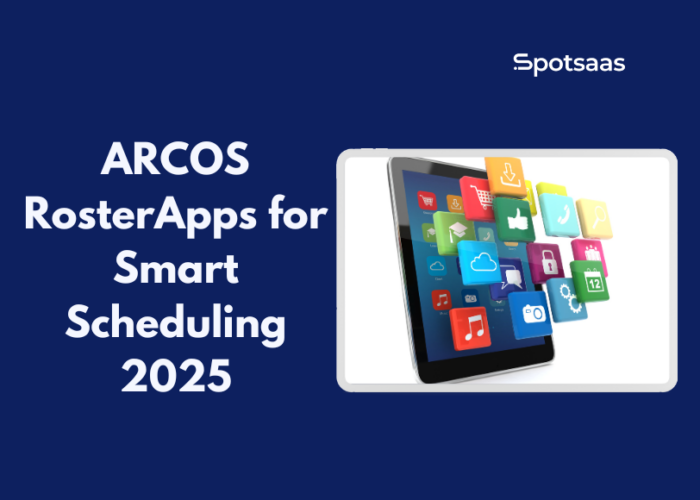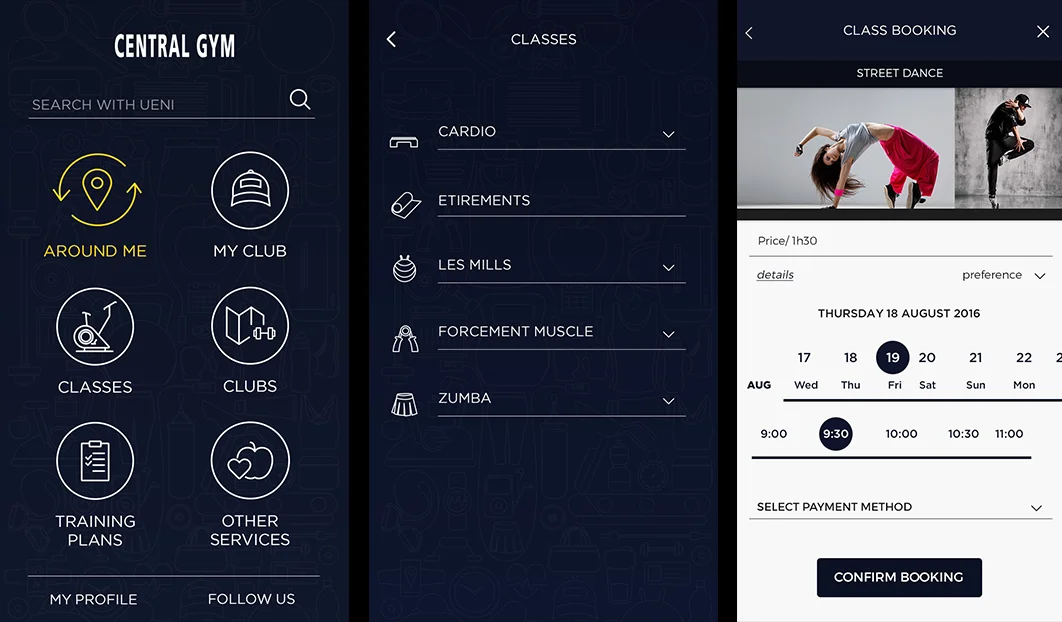In 2025, workforce scheduling is no longer a simple task it’s a strategic necessity. With rotating shifts, union rules, and the demand for real-time flexibility, traditional tools just don’t cut it. That’s why industries like utilities, aviation, and transportation are turning to smarter solutions.
ARCOS RosterApps is built specifically for complex, high-stakes environments where compliance, mobility, and automation matter. This blog breaks down its features, pricing, use cases, and how it compares to other scheduling software in today’s evolving landscape.
Key Takeaways
- ARCOS RosterApps is purpose-built for complex, unionized shift scheduling.
- It offers powerful features like shift bidding, compliance tracking, and real-time alerts.
- The platform supports mobile self-service and integrates with HR and payroll systems.
- Pricing is custom, reflecting each organization’s scale and scheduling needs.
- Compared to generic tools, RosterApps stands out for compliance, configurability, and industry focus.
What is ARCOS RosterApps?
ARCOS RosterApps is a cloud-based scheduling tool designed for industries where managing shifts is more complex than it looks. It caters specifically to sectors like aviation, utilities, and public transportation—where 24/7 operations, rotating shifts, and union rules are part of everyday life.
As part of the ARCOS suite, it helps managers and employees streamline scheduling, stay compliant with labor agreements, and respond quickly to changes. Unlike basic scheduling tools, RosterApps is built for high-stakes environments where structure, flexibility, and safety all matter.

Why Use ARCOS RosterApps?
ARCOS RosterApps isn’t a one-size-fits-all tool—it’s purpose-built for industries that deal with high-risk, high-complexity shift management.
- Industry-Specific Design: Built for utilities, aviation, and transit where scheduling is complex.
- Compliance Made Easy: Automates labor law and union rule enforcement to reduce legal risk.
- Time-Saving Automation: Speeds up shift assignments, approvals, and change management.
- Employee Self-Service: Allows staff to request shifts, time-off, or swaps via mobile.
- System Integration: Ensures consistent data across systems, reducing errors and rework.
- Real-Time Flexibility: Keeps teams running with fast, reliable schedule updates.
Find the Best Mobile Device Management Software in 2023
Key Features of ARCOS RosterApps
ARCOS RosterApps delivers a purpose-built feature set designed to meet the demands of complex, shift-based operations.
From compliance to mobility, these features ensure smoother scheduling, improved team communication, and reliable workforce coverage—even in high-pressure situations.
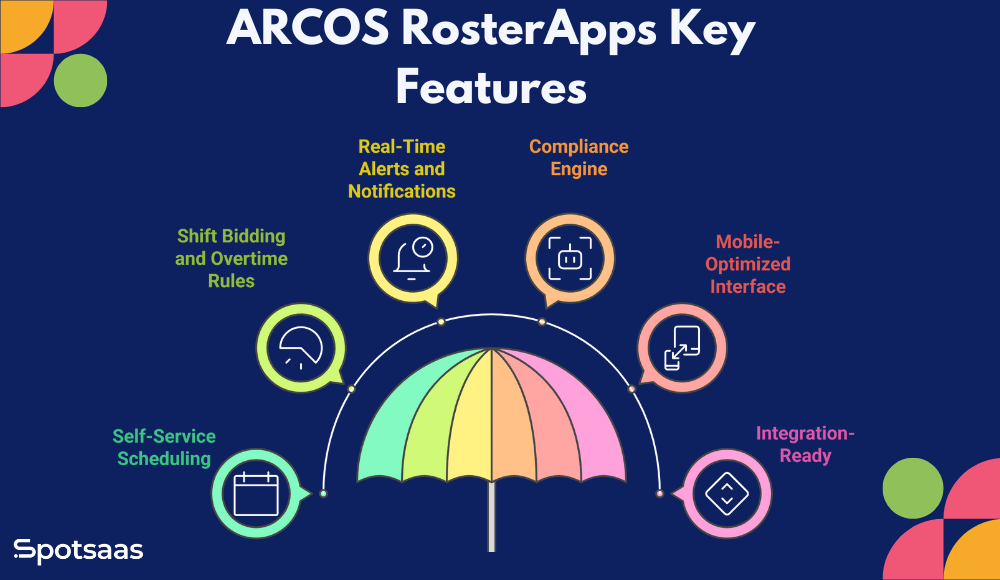
Self-Service Scheduling
Employees can access their employee schedule, request time off, and swap shifts through a simple, user-friendly interface—no more back-and-forth emails or manual updates.
This level of autonomy not only saves time for managers but also boosts employee satisfaction and accountability. With 24/7 access from any device, staff can handle scheduling needs on their own terms, leading to fewer disputes and more flexibility.
Shift Bidding and Overtime Rules
With ARCOS RosterApps, shift bidding is fully automated, giving employees an equal opportunity to bid for available shifts based on company-set criteria like seniority or skill level. This transparent process ensures fairness and helps maintain trust in unionized environments.
The system also automatically enforces overtime rules, preventing unintentional violations and reducing costly compliance risks. It helps balance workloads while respecting employee contracts and labor policies.
Real-Time Alerts and Notifications
The platform keeps everyone informed with real-time alerts for schedule changes, shift offers, and approvals. Managers can push out updates instantly, and employees receive notifications directly on their mobile devices—no need to chase people down.
This feature is critical for responding quickly to last-minute absences, emergencies, or operational changes, especially in industries where every minute counts.
Compliance Engine
Compliance isn’t just a feature—it’s a foundation of RosterApps. The platform allows organizations to program in detailed labor regulations, union agreements, and internal policies. It automatically applies those rules to each scheduling decision, ensuring that no policy is violated.
This helps avoid penalties, union grievances, and legal disputes, while also giving leadership confidence that their workforce management practices are aligned with the law.
Mobile-Optimized Interface
In today’s mobile-first world, RosterApps ensures employees and managers can perform critical scheduling tasks on the go. Whether in the field, on a job site, or in transit, users can quickly check their schedules, respond to shift offers, or make requests from any mobile device.
The intuitive mobile interface mirrors the desktop experience, ensuring consistency and ease of use across all touchpoints.
Integration-Ready
RosterApps is designed to integrate with major HR, payroll, and timekeeping systems, creating a seamless flow of data across platforms.
This eliminates the need for manual data entry, reduces errors, and ensures that all systems from scheduling to payroll are aligned in real time. It supports better reporting, faster approvals, and more informed decision-making across departments.
Pricing of ARCOS RosterApps
ARCOS RosterApps follows a custom pricing model, with costs based on factors like workforce size, scheduling complexity, industry needs, and system integrations. There’s no public flat rate—each package is tailored to match the client’s specific requirements.
It’s typically considered mid to premium-priced, but delivers strong ROI for industries where compliance, accuracy, and flexibility are essential. To get exact pricing, organizations must request a personalized quote from the ARCOS team.
Pricing options
As a flexible workforce management solution, ARCOS RosterApps offers various pricing options tailored to meet the unique needs of every organization. Let’s take a look at some of these options:
| Plan Type | Cost | Features |
|---|---|---|
| Free Version | $0 | Access to basic features |
| Premium Version | Varies | Access to all functionalities and enhanced features |
| Demo Version | Free | Limited time access to try out the platform’s capabilities |
Key Pricing Factors for ARCOS RosterApps
Several variables affect the pricing of ARCOS RosterApps, as the platform is customized to fit each organization’s size, complexity, and integration needs. Here are the key factors that determine your quote.
| Pricing Factor | Description |
|---|---|
| Number of Employees or Locations | Pricing adjusts based on how many workers or sites need to be managed. |
| Modules Required | Costs depend on whether you use only scheduling or the full ARCOS suite. |
| Integration Needs | Custom integrations with payroll, HR, or timekeeping systems may affect pricing. |
| Compliance Complexity | More complex union rules or labor law needs may require more configuration. |
| Support and Training | Level of onboarding, training, and ongoing support can influence the final cost. |
Benefits of Using ARCOS RosterApps
ARCOS RosterApps is more than just a scheduling tool—it’s a workforce operations solution built for complexity. Its benefits go beyond time savings, offering real advantages in compliance, communication, and adaptability across large, unionized, or shift-heavy teams.
Reduces Manual Scheduling Workload
RosterApps automates repetitive tasks like shift assignments, approvals, and availability tracking. Managers no longer have to juggle spreadsheets, phone calls, or handwritten requests—freeing them up to focus on operations and team leadership. This streamlining saves time and reduces administrative fatigue.
Improves Compliance and Reduces Risk
With built-in enforcement of labor laws, union rules, rest periods, and contract terms, RosterApps ensures that every schedule is compliant by default. This reduces the risk of legal issues, union grievances, or costly fines—especially in industries where compliance isn’t negotiable.
Boosts Workforce Flexibility and Agility
When disruptions happen like sudden absences, weather delays, or emergency responses RosterApps allows for quick, targeted rescheduling. Teams can adapt in minutes, not hours, and keep operations running smoothly. This real-time agility is critical for industries like utilities and aviation.
Enhances Employee Satisfaction
By giving employees control over their schedules like swapping shifts, viewing assignments, and requesting time off RosterApps increases transparency and trust. Empowered employees are more engaged, less frustrated, and more likely to stick around.
Minimizes No-Shows and Miscommunication
With automated alerts and real-time notifications, employees always know when their schedules change or when a shift becomes available. This clarity reduces last-minute confusion, call-ins, or missed assignments, which in turn improves overall attendance and accountability.
Scales with Your Organization
Whether you’re running a single team or coordinating thousands of employees across multiple locations, RosterApps scales to match your needs. It’s built for growth, making it a reliable long-term scheduling solution for expanding organizations.
Who Is ARCOS RosterApps For?
ARCOS RosterApps is built for organizations with large, dynamic, and union-regulated workforces where scheduling is high-stakes and operational downtime isn’t an option.
If your teams rely on round the clock coverage, rapid response, and strict compliance, this platform is designed for you.
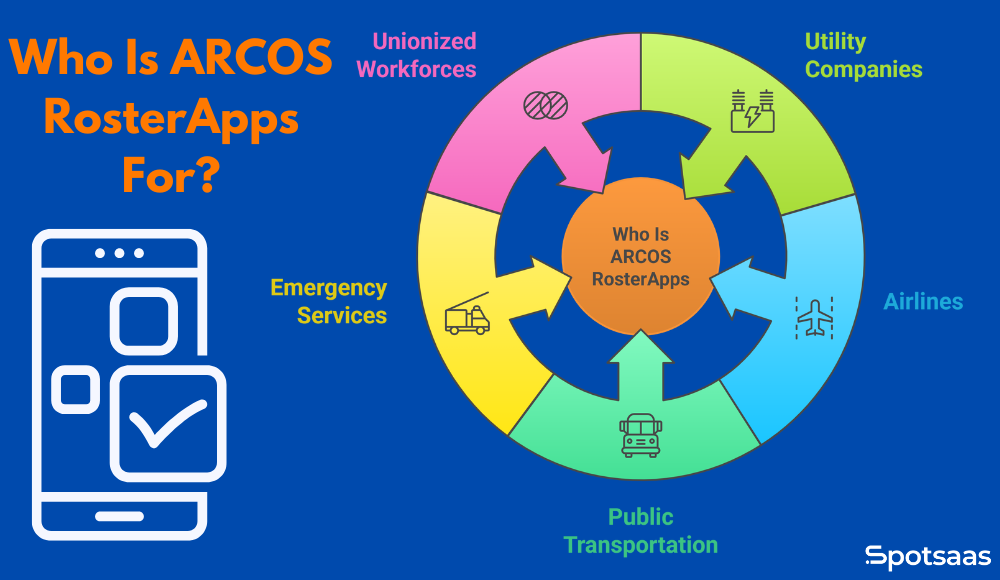
Utility Companies
RosterApps helps utilities manage large, dispersed field crews and respond quickly to emergencies like outages or natural disasters. It enables real-time crew assignments while ensuring compliance with labor rules and safety standards.
The system also helps utilities maintain 24/7 coverage, manage rotating shifts, and reduce manual communication during urgent events. This results in faster restoration times and better service reliability.
Airlines
From pilots to ground staff, airlines deal with complex staffing requirements across multiple departments. RosterApps simplifies shift bidding, qualifications tracking, and union rule compliance—reducing scheduling conflicts and operational delays.
It also supports real-time updates and mobile access for crew members, helping ensure smooth operations even during weather delays or last-minute cancellations.
Public Transportation Agencies
Transit operations depend on tight schedules and rotating shifts. RosterApps helps ensure full route coverage while balancing employee preferences, union rules, and last-minute changes without disrupting service.
It gives schedulers the flexibility to adjust staffing during service disruptions while keeping operators informed and compliant with shift and rest policies.
Emergency Services
Whether it’s fire, EMS, or disaster response, emergency services need rapid, reliable scheduling. RosterApps allows fast reallocation of staff during critical events, ensuring teams are where they’re needed—without delay or confusion.
It also keeps track of certifications, availability, and shift hours so that the right responders are always on call, ready, and within policy.
Unionized Workforces
In industries governed by labor contracts, RosterApps makes it easier to stay compliant with union rules, seniority systems, and overtime regulations. It reduces manual oversight and minimizes disputes by automating complex scheduling logic.
The platform provides transparency and fairness in scheduling decisions, which builds trust with employees and helps prevent labor conflicts or grievances.
RosterApps vs Generic Scheduling Tools
While many scheduling platforms offer basic shift management features, ARCOS RosterApps is built specifically for industries that demand precision, compliance, and flexibility.
Generic tools may work for small businesses or hourly teams, but they often fall short in high-stakes, unionized, or emergency-driven environments.
Feature Comparison Table
Below is a comparison of how RosterApps stacks up against popular generic scheduling tools like Deputy and When I Work:
| Feature | RosterApps | Generic Tools |
|---|---|---|
| Union Rule Compliance | ✅ Fully supported | ❌ Not built for union environments |
| Shift Bidding & Rotations | ✅ Transparent & automated | Limited functionality |
| Real-Time Emergency Scheduling | ✅ Built-in | ❌ Lacks urgency tools |
| Mobile Self-Service | ✅ Fully mobile-ready | ✅ Basic access available |
| Industry Specialization | Utilities, Aviation, Transit | Retail, Hospitality |
| Compliance Automation | ✅ Embedded into system logic | ❌ Manual tracking required |
| Custom Configurability | High – tailored to operations | Moderate – basic setup |
| Custom Pricing | Yes – based on needs | Yes/No – varies by provider |
Why Workforce Scheduling Needs Have Evolved in 2025
Scheduling has evolved from simply filling shifts to balancing compliance, flexibility, and employee satisfaction.
In 2025, organizations need smarter systems to meet modern workforce expectations—and ARCOS RosterApps is built to do exactly that.
Mobile-First Operations
- Employees expect to access schedules and make changes from their smartphones, allowing them to manage work from anywhere with ease. Mobile functionality is no longer optional—it’s expected for engagement and efficiency.
- Mobile tools streamline communication and reduce the need for in-person or email-based updates, saving time and minimizing errors. They also help teams stay connected across locations or departments.
- Push notifications and real-time alerts keep teams informed instantly so no one misses critical updates. This instant visibility supports accountability and responsiveness.
Compliance Pressure
- Labor laws and union agreements are more detailed and enforceable than ever, making manual tracking risky and inefficient. Organizations must build compliance into every shift, not check it after the fact.
- Manual oversight increases the risk of compliance errors and grievances, leading to fines, disputes, or operational delays. Automation helps reduce this burden dramatically.
- Built-in rule enforcement ensures shifts follow contracts and legal guidelines, maintaining fairness and protecting against legal exposure. It also strengthens relationships with unions and regulatory bodies.
Real-Time Flexibility
- Unexpected changes like callouts, delays, or outages require instant action, and delays in coverage can disrupt service delivery. A slow response can impact customer trust and safety.
- Managers need tools to adjust coverage quickly and confidently, without relying on manual call trees or last-minute scrambling. Real-time access gives them the control they need.
- Real-time shift reassignments reduce downtime and service disruption by ensuring immediate visibility into who’s available, qualified, and ready. This helps maintain performance even during chaos.
AI-Assisted Forecasting
- AI uses trends, historical data, and external factors to predict staffing needs, helping you stay ahead of demand with more precision. It adds intelligence to every planning decision.
- Demand planning becomes more accurate and efficient over time, as the system learns and adapts to your organization’s patterns. This improves long-term resource management.
- Helps avoid overstaffing or shortages, especially during seasonal peaks, reducing unnecessary costs while maintaining service standards. Smarter labor allocation means better outcomes.
- Reduces reliance on guesswork and allows proactive schedule planning that’s aligned with actual business needs. You shift from reactive to strategic workforce management.
Employee Autonomy
- Self-service tools let staff handle shift swaps, availability, and PTO requests on their own, giving them more control over their work-life balance. This autonomy reduces friction and delays.
- Empowers employees and reduces bottlenecks for managers, who no longer have to manually manage every request or change. It promotes independence and trust on both sides.
- Increases transparency and trust in the scheduling process by showing how decisions are made and applied fairly. It builds a sense of ownership among employees.
- Boosts retention by offering more control over work-life balance, which leads to higher morale and lower turnover in competitive labor markets. Happy employees stay longer and perform better.
ARCOS RosterApps vs. Other Scheduling Platforms
While many scheduling tools offer solid features for general workforce management, not all are designed to handle union compliance, emergency staffing, or high-volume shift complexity.
ARCOS RosterApps stands apart by addressing these needs directly. Here’s how it compares to some of the leading platforms in the market:
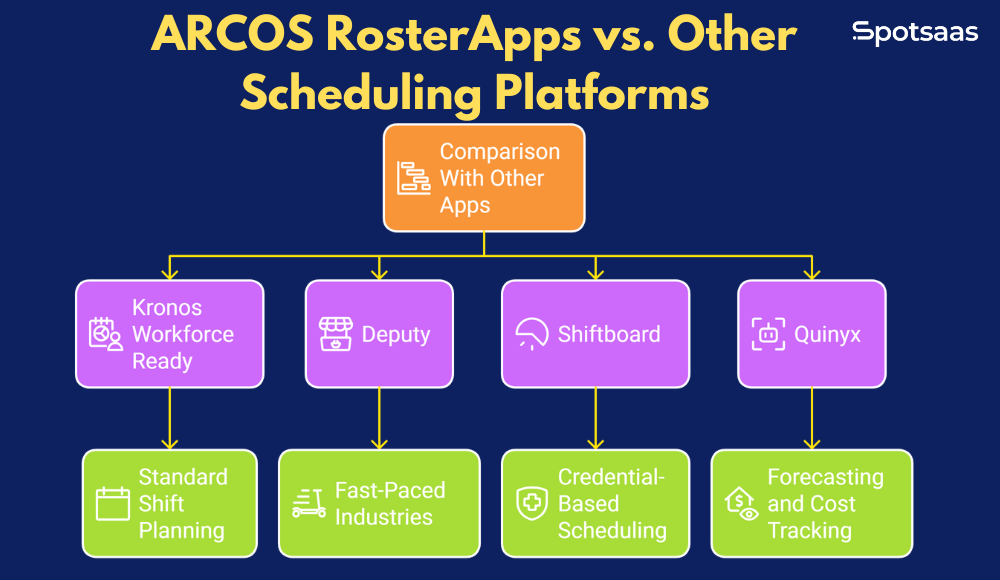
Kronos Workforce Ready (UKG Ready)
Kronos now UKG Ready is a widely used workforce management platform known for its strong timekeeping and HR integration. It’s a robust solution for companies focused on payroll, attendance tracking, and broad workforce analytics.
While it supports scheduling, its configuration options are better suited to standard shift planning rather than highly regulated or emergency-driven environments. For businesses in complex sectors, it may require additional customization to meet specific compliance demands.
Key Features:
- Time and attendance tracking
- Workforce analytics and reporting
- Payroll and HR integration
- Basic scheduling capabilities
Why ARCOS is stronger: ARCOS offers more advanced rule handling, stronger compliance enforcement, and real-time operational responsiveness tailored to industries like utilities and aviation.
Deputy
Deputy is a user-friendly scheduling solution designed for fast-paced, customer-facing industries like retail, hospitality, and food service. It provides a simple interface, easy setup, and strong mobile capabilities, making it ideal for smaller teams or single-location businesses.
However, it isn’t built to manage the complexity of union contracts or compliance-heavy scheduling environments, which limits its application in sectors like transportation or energy.
Key Features
- Drag-and-drop schedule builder
- Shift swapping and time-off requests
- Mobile employee check-in
- Task assignment tools
Why ARCOS is stronger: ARCOS enables complex rule-based scheduling, bid management, and better support for labor law compliance—all crucial for regulated industries.
Shiftboard
Shiftboard focuses on industries where compliance and credential-based scheduling are critical—such as manufacturing, healthcare, and energy.
It offers solid scheduling logic, worker qualification tracking, and tools to manage fatigue and overtime. It’s more advanced than typical scheduling software but still may not match the depth ARCOS offers in emergency staffing and real-time shift coverage.
Key Features
- Rule-based scheduling
- Certifications and qualification tracking
- Overtime and fatigue management
- Employee self-service portal
Why ARCOS is stronger: ARCOS stands out for its mobile-first emergency scheduling, utility-industry focus, and deeper union rule configurability.
Quinyx
Quinyx is a modern, AI-driven platform focused on workforce forecasting and labor optimization. It’s commonly used in retail, logistics, and service sectors to improve staffing efficiency and reduce costs.
Its forecasting tools are powerful, but it’s not designed for unionized environments or emergency response scheduling. That makes it less ideal for teams that need strict labor rule enforcement or real-time adaptability.
Key Features
- AI-based demand forecasting
- Labor cost tracking
- Mobile app for staff engagement
- Integration with major HR systems
Why ARCOS is stronger: ARCOS is better suited for teams that need compliance-backed scheduling, emergency shift reassignment, and operational control in regulated industries.
ARCOS RosterApps Login Process
Accessing ARCOS RosterApps gives employees and supervisors the ability to manage their work schedules, shift bids, time-off requests, and urgent staffing needs. Here’s a detailed breakdown of how to log in and what to expect, especially if you’re a first-time user.
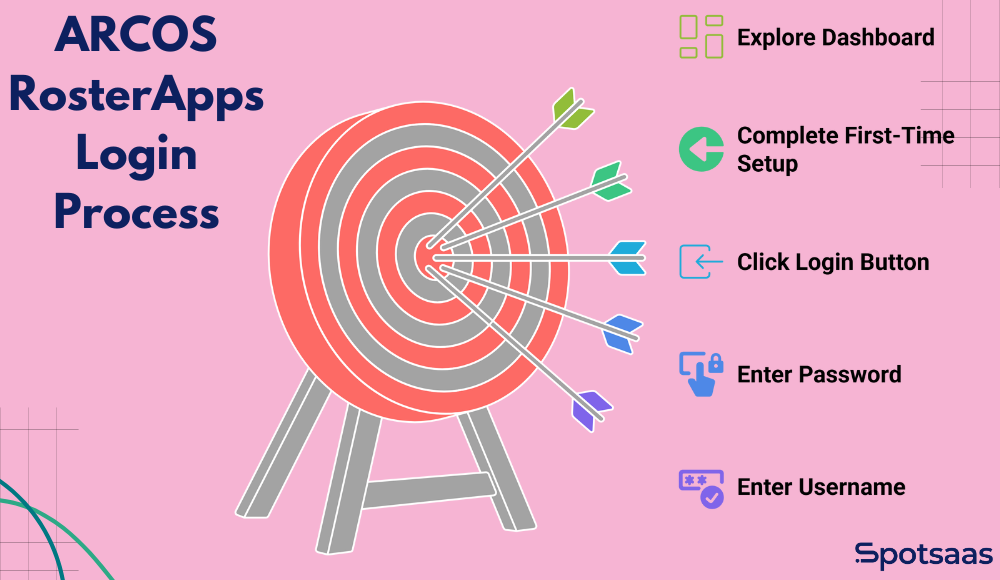
Step 1: Navigate to the Login Page
To get started, open any web browser and go to the official RosterApps login portal:
Some organizations may use a custom login URL that redirects to a company-specific portal. If the above link doesn’t load or shows an error, it’s possible your company has a dedicated login page. In that case, contact your HR department, system administrator, or supervisor to get the correct web address.
Step 2: Enter Your Username
Your username is typically based on how your company set up your RosterApps access. Most commonly, it will be one of the following:
- Your company email address
- Your employee ID or personnel number
If you’re unsure which format to use, reach out to your manager or HR representative they can quickly verify your login credentials.
Step 3: Enter Your Password
Enter the password associated with your RosterApps account. If you’re logging in for the first time, you might have received a temporary password via email or directly from your administrator. Passwords are case-sensitive, so be sure to enter them exactly as provided.
Once logged in for the first time, you’ll likely be asked to change this temporary password to something more secure.
Step 4: Click the “Login” Button
After entering your username and password, click the Login button. If your credentials are valid, the system will redirect you to your dashboard. If not, double-check for typos or check with HR to confirm that your account is active and set up correctly.
Step 5: Complete First-Time Setup (New Users Only)
If you’re a new user, RosterApps will prompt you to complete a brief onboarding setup after your first login. This setup may include:
- Creating a new, secure password
- Setting or answering security questions for account recovery
- Verifying your email address or mobile phone number for alerts and notifications
These steps help protect your account and enable system notifications like shift changes, approvals, or emergency staffing requests.
Step 6: Explore the Dashboard
Once you’re logged in and past the initial setup, you’ll land on your dashboard. Depending on your role and how your company configured RosterApps, you’ll be able to:
- View your daily, weekly, or monthly work schedule
- Bid on available shifts (if shift bidding is enabled)
- Submit time-off requests or shift changes
- Respond to emergency callouts or staffing needs
- View important notifications and schedule updates
The dashboard layout and features will vary depending on your user role (employee, supervisor, manager) and your organization’s specific system setup.
Forgot Your Password?
If you can’t remember your password, click the “Forgot Password?” link on the login page. RosterApps will guide you through a secure reset process, which may involve:
- Answering your previously set security questions
- Receiving a password reset link by email
Once reset, you can create a new password and regain access to your account without needing help from IT or HR.
Conclusion
ARCOS RosterApps is built for organizations where scheduling isn’t just about coverage—it’s about compliance, agility, and operational resilience.
With robust features, real-time tools, and deep industry alignment, it gives teams the control they need to manage complex workforces effectively. If your operation depends on precision and performance, RosterApps is a smart choice for 2025 and beyond.
It reduces risk, saves time, and empowers both managers and employees to work smarter. For industries that can’t afford scheduling errors, ARCOS RosterApps delivers the reliability and scalability they need.
Frequently Asked Questions
What is ARCOS RosterApps used for?
ARCOS RosterApps is used to automate and manage employee scheduling, shift bidding, time-off requests, and compliance in union-regulated or complex shift environments.
Is ARCOS RosterApps only for utility companies?
No. While it’s widely used in the utility sector, it’s also ideal for aviation, public transportation, emergency services, and any industry with rotating shifts and strict scheduling requirements.
Can employees access RosterApps from their phone?
Yes. RosterApps is fully mobile-optimized, allowing employees to view schedules, request shifts, and get real-time alerts from any device.
Does ARCOS RosterApps integrate with payroll and HR systems?
Yes. It integrates with popular HRIS, payroll, and timekeeping systems, ensuring seamless data flow and reducing manual entry errors.
How is ARCOS RosterApps priced?
Pricing is custom and depends on workforce size, scheduling needs, required modules, and integrations. Organizations must request a tailored quote from ARCOS.

